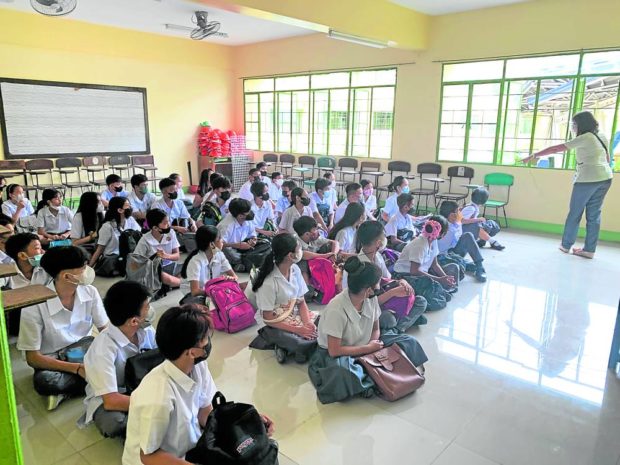
FLOORED | Grade 7 students in Manila’s Jose Abad Santos High School sit on the floor on their first day back on campus although a school official tells the Inquirer there are enough chairs for all their students. (Photo by JANE BAUTISTA / Philippine Daily Inquirer)
MANILA, Phililppines — Long lines at public transport terminals and heavy traffic greeted Metro Manila commuters on Monday, the first day of simultaneous in-person classes for thousands of students after the COVID-19 pandemic shuttered schools two years ago and prompted a shift to online learning.
Beng Soriano, a regular Edsa Carousel commuter, said it took her nearly an hour to get on a bus. Even though it was only 6 a.m., the line for commuters at Bagong Barrio, which included many students, had already spilled over onto Edsa, all of them waiting patiently under a heavy downpour.
The line for the Metro Rail Transit 3 was also equally long, Soriano observed.
Princess, a student at a school in Quezon City, said that to avoid being late, she left her house in Caloocan City two hours early. “No matter how excited you are for school, you no longer get excited as soon as you see how hard it is to commute,” she told the Inquirer.
But aside from the sudden swell of commuters and heavy rains, there was another factor that exacerbated the flow of traffic — the lack of public transportation.
Obet Martin, chair of transport group Pasang Masda, explained that in the past two years that there were no physical classes, several displaced jeepney drivers were forced to either sell their vehicles for scrap or change jobs to make ends meet.
Other drivers, he said, opted not to ply their routes because of high gas prices. As a result, there were not enough jeeps plying several routes, particularly Project 8 and Lagro in Quezon City, and the University Belt in Manila.
More routes needed
“We know this is just the start. What more if regular classes really hit their stride?” he said. “However, we in the transport sector see this as a challenge and we anticipate more and more drivers to come back to the road as soon as the Land Transportation Franchising and Regulatory Board (LTFRB) opens more routes and more franchises.”
Still, their absence was immediately felt as operating public utility vehicles (PUVs) struggled to cope with the surge of commuters, including students, said Julius Dalay, chair of Commuters of the Philippines.
Making matters worse was the sudden change in PUV routes, leaving many of their drivers confused and slowing down turnarounds.
The LTFRB recently issued Memorandum Circular (MC) No. 2022-067, reopening 33 bus routes in addition to MC No. 2022-068, which opened 68 jeeps and 32 UV Express routes.
These reopened routes, Martin said, were old ones that were suspended during the pandemic to make room for the Department of Transportation’s (DOTr) planned route rationalization plan, which sought to consolidate Metro public transport routes to make these more efficient.
Many PUV drivers “were probably disoriented and merely needed time to readjust” to the old routes, he said, adding: “But we’re anticipating that the LTFRB will reopen more routes as well as open new ones to accommodate the commuting public.”
Dulay also observed that many students, especially middle-class ones, went to school in private vehicles.
“Many parents and students are, of course, still worried about COVID-19 and monkeypox and wanted to make sure that they do not contract the virus in crowded places,” he said. “But this led to so many cars on the road, resulting in gridlock.”
According to Dulay, the DOTr and LTFRB should fast-track the reopening of public transport routes to allow more jeepneys to return to the road.
He also urged transport agencies to hold dialogues with PUV operators to address their drivers’ concerns, such as high gas prices.
RELATED STORIES
Gov’t must ensure availability of more PUVs ahead of face to face classes — Poe
MMDA lifts number coding for PUVs
11,000 Metro Manila PUVs back by Monday